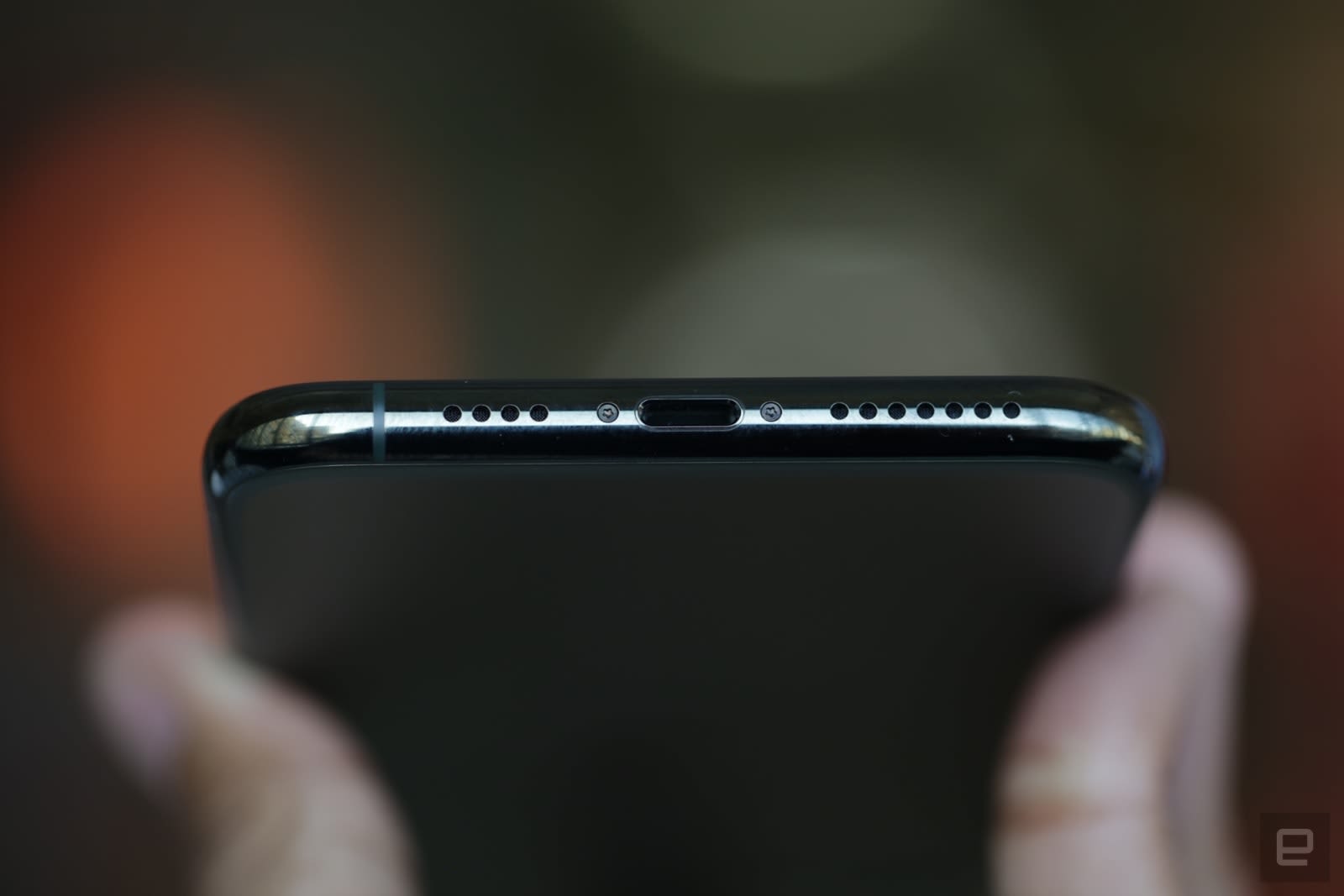The European Parliament has renewed its push for a phone charger standard through an amended draft law, and it won’t surprise you to hear that Apple has raised objections. The iPhone maker has issued a statement arguing that rules dictating a common connector in phones “stifles innovation” and would hurt the public more than it helped. To support its claims, the company commissioned a study from Copenhagen Economics claiming that a common charger move would cost €1.5 billion (about $1.7 billion), more than negating the €13 million ($14.4 million) in potential environmental benefits. It even suggested the EU might create an environmental problem by “disrupting” hundreds of millions of people who use Apple devices with Lightning ports.
Tech
Apple says EU push for universal phone charger would 'stifle innovation' – Engadget
Apple also felt that rules weren’t necessary when the industry was already consolidating around USB-C, either through port changes or through cables (as with the iPhone 11 Pro). The industry has consolidated from “30 chargers to three, soon to be two,” Apple said. It still hoped the European Commission would look for a solution — just not one that hurt the industry’s (read: Apple’s) “ability to innovate.”
You can read Apple’s full statement below.
The EU has been pressing for harmonized phone charging for over a decade, arguing that it would reduce e-waste and simplify the experience for customers. You might not even need a new charger in the box alongside your new phone. To date, though, it has relied on a voluntary approach that it doesn’t believe has been effective. Regulation would theoretically push exceptions like Apple to do what they won’t on their own accord.
Whether or not mandatory adoption would help isn’t clear. While USB-C has made life considerably easier in the smartphone world, it didn’t start reaching phones until 2015, or three years after Lightning (which included many of USB-C’s design advantages) made its debut in the iPhone 5. Widespread adoption took a while after that. As genuinely helpful as a standard could be, there is a risk you could wait longer for meaningful advances.
“Apple stands for innovation and deeply cares about the customer experience. We believe regulation that forces conformity across the type of connector built into all smartphones stifles innovation rather than encouraging it, and would harm consumers in Europe and the economy as a whole.
“More than 1 billion Apple devices have shipped using a Lightning connector in addition to an entire ecosystem of accessory and device manufacturers who use Lightning to serve our collective customers. Legislation would have a direct negative impact by disrupting the hundreds of millions of active devices and accessories used by our European customers and even more Apple customers worldwide, creating an unprecedented volume of electronic waste and greatly inconveniencing users.
“We do not believe there is a case for regulation given the industry is already moving to the use of USB Type-C through a connector or cable assembly. This includes Apple’s USB-C power adapter which is compatible with all iPhone and iPad devices. This approach is more affordable and convenient for consumers, enables charging for a wide range of portable electronic products, encourages people to re-use their charger and allows for innovation.
“Prior to 2009, the Commission considered mandating that all smartphones use only USB Micro-B connectors which would have restricted the advancement to Lightning and USB Type-C. Instead, the Commission established a voluntary, industry standards-based approach that saw the market shift from 30 chargers down to 3, soon to be two — Lightning and USB-C, showing this approach does work.
“We hope the Commission will continue to seek a solution that does not restrict the industry’s ability to innovate and bring exciting new technology to customers.”
Tech
For Practitioners, by Practitioners: Solve Your Software Challenges at InfoQ & QCon Software Events – InfoQ.com

Behind every InfoQ Dev Summit and QCon software development conference is a collective of distinguished senior software practitioners who carefully curate the topics based on the crucial trends and essential best practices you need to know about. These architects and leaders are charged with creating THE conference they would want to attend.
While some conferences issue calls for papers, InfoQ Dev Summit and QCon hand-select all the speakers. Domain experts individually select each talk for fit and merit. We search for the talks and find the speakers you want to learn from. These are not always the most famous people, but they are often the most compelling voices you’ll find in software.
Once the speakers are found, they undergo multiple interviews (with committee members, track hosts, and the conference chair) and a mandated rehearsal process before speaking at InfoQ Dev Summit and QCon. We offer training webinars, mentorship, and slide/code reviews with past speakers to enhance our speakers’ presentations, so they are sharp by the time they get to you. We take your time and conference investment as seriously as you do. We value the trust you place in us.
If you’re curious to see what types of talks you’ll find at InfoQ Dev Summit and QCon, take a look at a few recent talks:
- How Netflix Really Uses Java: At QCon San Francisco 2023, Paul Bakker, Java Platform @Netflix, Java Champion, and Co-Author of “Java 9 Modularity”, explored the current Netflix architecture(s). He provided a deep dive into how and why the architecture evolved the way it did and related this to the evolution of the Netflix Java tech stack.
- Banking on Thousands of Microservices: Suhail Patel, Staff Engineer @Monzo, shared at QCon London 2023 the lessons he and his team learned from building an online bank. He discussed technological choices, such as using Cassandra and Kubernetes in the early days, and explored how @Monzo has maintained its speed of execution through a focus on platform engineering and developer experience.
- Why Technical Experience Matters: How to Build a Lifelong Career in Software Development: At QCon London 2023, Sven Reimers, System Engineer @Airbus Defence & Space, shared how you can be a lifelong software developer. He discussed how to have your deep technical expertise valued by the industry and the role you can play in mentoring the next generation.
We believe InfoQ Dev Summit and QCon conferences are special experiences. If you’ve never been before, you owe it to yourself to understand why our conferences are so popular among developers and architects. Come find out why we’ve earned the reputation as a conference of “practitioners talking to practitioners.” You won’t forget the experience.
The upcoming software development conferences for 2024:
P.S. Teams as small as 3 attendees working for the same company are eligible for a group discount. For more details, email info@qconferences.com and mention the conference and size of the group to receive your discount code.
P.S.S. Due to popular demand, we’re extending the early bird dates for InfoQ Dev Summit Boston and Munich by two weeks for InfoQ readers. Save $100 for InfoQ Dev Summit Boston with code LIMITEDOFFERIDSBOSTON24 and €75 for InfoQ Dev Summit Munich with promo code LIMITEDOFFERIDSMUNICH24 when registering. Valid until May 6.
Tech
The Ultimate Recap of Sea Otter 2024 – Pinkbike.com


Vittoria Releases New Peyote & Mezcal XC Race Tires
Maxxis Team Spec Aspen ST Tire
New DT Swiss 240 DEG Hubs
Kali Protectives’ New Full Face Helmets
Industry Nine’s SOLiX M Hubs & Wheelsets
Michelin’s Aggressive New Wild Enduro Tires
Praxis’ New Flat Pedals, Stem, & Carbon Bottle Cage
Transmission Cage Upgrades from Kogel, Ceramicspeed, and Cascade Components
Randoms Round 1 – Sea Otter 2024
Madrone Cycles’ SRAM Eagle Repair Kits & Prototype Derailleur
Vorsprung’s New Telum Coil Shock
EXT’s Vaia Inverted DH Fork & Updated Coil Shocks
Randoms Round 2: New Tools, Goggles, Grips, Racks, & More – Sea Otter 2024
What’s New in Women’s MTB Apparel at Sea Otter 2024
Even More Randoms – Sea Otter 2024
Randoms Round 3: Dario’s Treasures
What’s New for the Kids at Sea Otter 2024
Deity Releases New Stems, Grips, & Pedals
Dario’s Final Sea Otter Randoms
Brian’s Randoms from Sea Otter 2024
Videos
With roots dating back to 1991, the Sea Otter Classic is one of the biggest biking events and tradeshows each year and brings together all sides of the biking industry from athletes to brands, spectators and consumers. Taking place in April in the sunny hills of Monterey, California, that means this event really feels like the official start to the biking season in North America. Christina Chappetta covers why it’s much different to an indoor European biking tradeshow, a World Cup racing weekend or even Crankworx mountain bike festival, in that it encompasses nearly ALL of the biking disciplines, including road cycling, enduro, downhill, dual slalom, XC, trials riding and more.
In the past fortnight, we have seen large amount of new tech releases. However, Sea Otter 2024 represents some of the first opportunities for many riders to see these things in the flesh, as well as take a deeper dive into what the product aims to do.
Welcome to a video summary from Day 2 of the Sea Otter Classic.
There are so many giveaways, interesting new products and colourful characters at Sea Otter Classic that it’s hard to stand out from the crowd. Ben Cathro takes a lap of the venue to find his favourites.
Tech
Apple iPad Air 2024: Insider Makes Hasty U-Turn On New Feature – Forbes


Well, that was quick. On May 18, a respected industry insider predicted a new display technology for the iPad Air that’s expected in the coming days—Apple just announced its latest special event.
The new 12.9-inch iPad Air, the report claimed, would have the same miniLED backlighting currently found on the larger iPad Pro, using the leftover inventory from the current Pro as that model switches to OLED. That was exciting news.
But now, Ross Young, the analyst who made the claim, has changed his mind. The new prediction, shared with paid subscribers only, is that the miniLED technology won’t be coming to the iPad Air, in either size.
While it made sense that the inventory could be maximized in this way, it now “makes sense” that it won’t.
Young says that while he’d heard from supply chain sources that it would, he’d now had contact from “even more supply chain sources” that it won’t.
And the reason this change of heart now makes sense is that this miniLED technology is expensive, so it would be surprising if it made it to the iPad Air, which is more affordable than the Pro.
That’s not quite all the analyst shared. He also said that there are now reports of a new iPad coming later in the year. This is a 12.9-inch iPad, with miniLED backlighting and it could arrive between October and December this year.
function loadConnatixScript(document)
if (!window.cnxel)
window.cnxel = ;
window.cnxel.cmd = [];
var iframe = document.createElement(‘iframe’);
iframe.style.display = ‘none’;
iframe.onload = function()
var iframeDoc = iframe.contentWindow.document;
var script = iframeDoc.createElement(‘script’);
script.src = ‘//cd.elements.video/player.js’ + ‘?cid=’ + ’62cec241-7d09-4462-afc2-f72f8d8ef40a’;
script.setAttribute(‘defer’, ‘1’);
script.setAttribute(‘type’, ‘text/javascript’);
iframeDoc.body.appendChild(script);
;
document.head.appendChild(iframe);
loadConnatixScript(document);
(function()
function createUniqueId()
return ‘xxxxxxxx-xxxx-4xxx-yxxx-xxxxxxxxxxxx’.replace(/[xy]/g, function(c)
var r = Math.random() * 16 );
const randId = createUniqueId();
document.getElementsByClassName(‘fbs-cnx’)[0].setAttribute(‘id’, randId);
document.getElementById(randId).removeAttribute(‘class’);
(new Image()).src = ‘https://capi.elements.video/tr/si?token=’ + ’44f947fb-a5ce-41f1-a4fc-78dcf31c262a’ + ‘&cid=’ + ’62cec241-7d09-4462-afc2-f72f8d8ef40a’;
cnxel.cmd.push(function ()
cnxel(
playerId: ’44f947fb-a5ce-41f1-a4fc-78dcf31c262a’,
playlistId: ‘aff7f449-8e5d-4c43-8dca-16dfb7dc05b9’,
).render(randId);
);
)();
This is intriguing. What could it be? Assuming that the iPad Pro and iPad Air are released in May, it’s extremely unlikely either will be updated later in the year. And if the iPad Air isn’t pricey enough for miniLED to be included, what tablet could Apple be introducing that is the same size as the bigger Pro, with a pricey screen tech, which would sit between the Air and the Pro, it seems?
Young is highly reliable, but this seems slightly preposterous to me. The only other iPad in the range due a refresh is the regular iPad (at 12.9-inches, the iPad mini is clearly out of the picture) and that doesn’t seem likely either.
It seems to me that any regular iPad will almost certainly have the same screen size as now, 10.9 inches. The regular iPad only grew to this size screen in the current generation, and Apple almost never changes designs after one iteration.
Perhaps things will become clearer as the year goes on.
-
Media19 hours ago
B.C. online harms bill on hold after deal with social media firms
-
Media24 hours ago
Trump poised to clinch US$1.3-billion social media company stock award
-
Real eState20 hours ago
Montreal tenant forced to pay his landlord’s taxes offers advice to other renters
-



 Investment20 hours ago
Investment20 hours agoMOF: Govt to establish high-level facilitation platform to oversee potential, approved strategic investments
-



 Politics19 hours ago
Politics19 hours agoPolitics Briefing: Younger demographics not swayed by federal budget benefits targeted at them, poll indicates
-
News19 hours ago
Just bought a used car? There’s a chance it’s stolen, as thieves exploit weakness in vehicle registrations
-



 Science19 hours ago
Science19 hours agoGiant prehistoric salmon had tusk-like spikes used for defence, building nests: study
-



 Tech18 hours ago
Tech18 hours agoCalgary woman who neglected elderly father spared jail term








